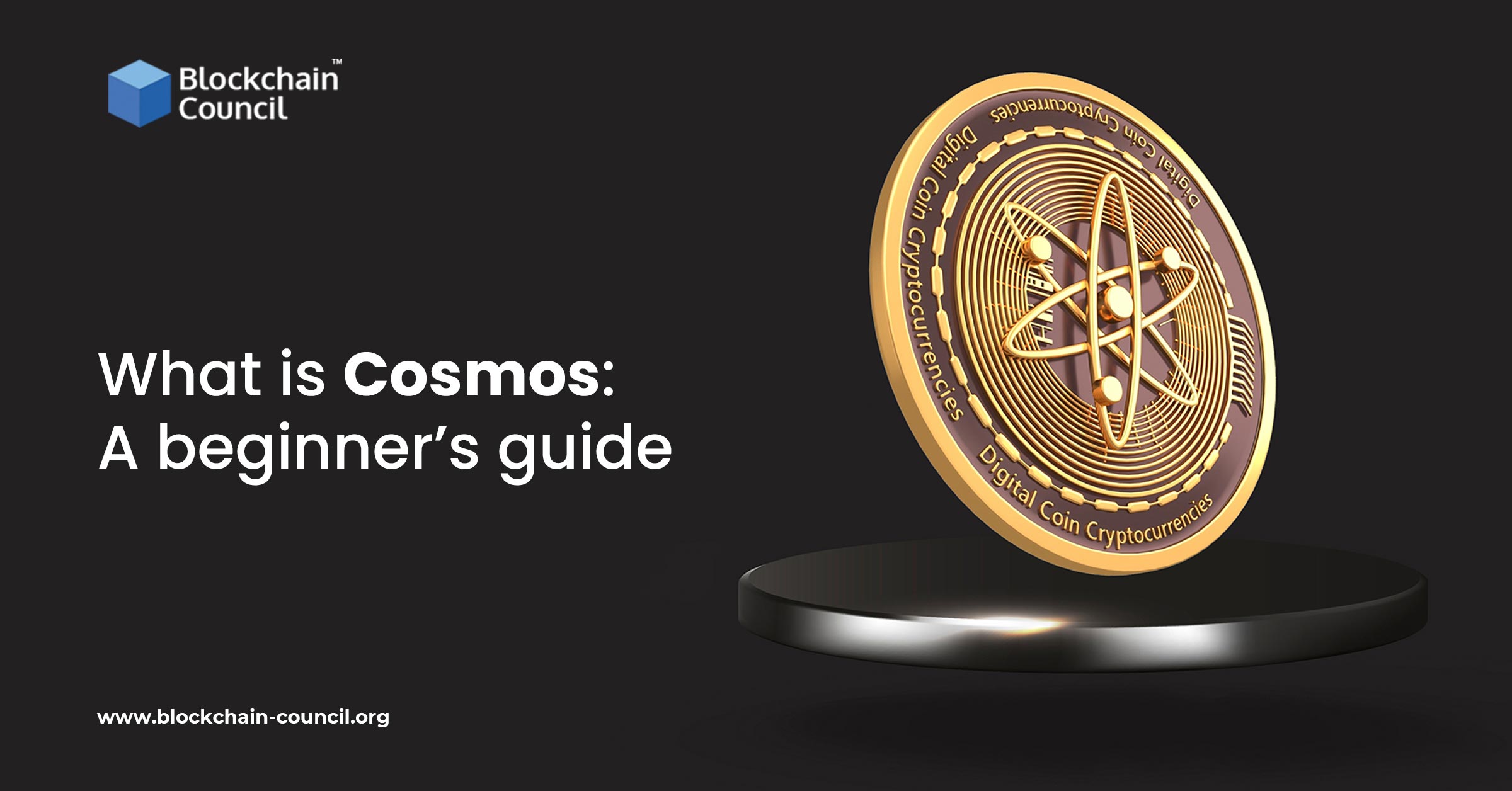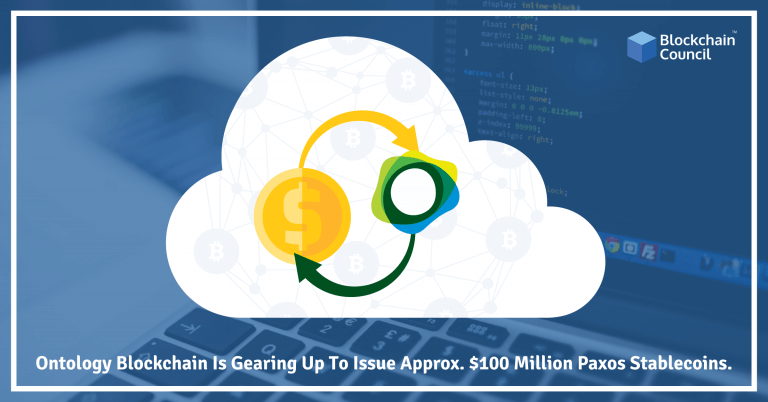
- Blockchain Council
- June 14, 2022
The cryptocurrency market has been showing a solid CAGR or Compound Annual Growth Rate of over 6.5% globally for the past couple of years. This massive growth rate indicates how it is prefered over regular currency and forex markets around the globe. Blockchain technology has helped form the crypto market’s backbone by powering it and allowing it to penetrate the mass market. A study said that blockchains need to communicate with each other if the crypto market is somehow likely to attain its real potential. This phenomenon is termed “interoperability”, and Cosmos is one of the first blockchain concepts looking after this issue. Cosmos is already one of the biggest names in the crypto and blockchain industry and has gained partnerships from some of the biggest cryptocurrencies.
Since blockchains form their separate universe, inter-chain communication is very challenging. Connecting all the blockchain universes and the subsequent cryptos will create a united and organized system that makes trading and investing more accessible. Cosmos has stepped up to tackle that issue, and people are more than eager about this technique. Hence more and more people are learning about cryptos and the very core concept of blockchain. You do so, too, with some of the best blockchain certification courses if you want.
Now that we have a quick introduction about the cryptos, blockchains and the Cosmos, let us dive deeper and know everything related to Cosmos.
What is Cosmos?
Cosmos, also termed the “Internet of Blockchain”, is based on two core concepts. The first one is interoperability and the second one is customization. These two concepts set Cosmos apart from all the other crypto blockchains. One of the primary goals served by Cosmos is it wants to create a decentralized yet highly optimized ecosystem. The networks it wants to generate should adequately manage the various crypto blockchains.
Cosmos works independently and creates independent blockchain systems known as “zones”. These zones are interconnected to a central hub, also known as the Cosmos Hub. The hub regularly studies the condition of each of these zones and creates reports based on its study, while the zones do the same for the hub. The Cosmos Hub is quite an interesting part that you can learn about through online blockchain technology training courses.
The hub is maintained and majorly powered by a specific Proof of Stake consensus mechanism. Moreover, Cosmos operates its native cryptocurrency known as ATOM. When there is a native crypto present, the transaction validators in the network are solely decided through the amount of ATOM holdings that are pledged to the essential operation of the overall Cosmos network.
Staking is quite a relevant term in this scenario since it explains the process of dedicating a specific amount of currency to the sole operation of the entire blockchain system. If you learn blockchain technology, you can get a better insight into the internal processes of Cosmos and ATOM.
History of Cosmos
Cosmos initially made its appearance in 2014 and was created by Jae Kwon under a consensus protocol named Tendermint. Kwon alone could not build the complete interoperable system, so he partnered with Zarko Milosevic and Ethan Buchman. Kwon eventually stepped down from his services in the Cosmos project in 2020.
Here is a brief chronological timeline of Cosmos, highlighting the various milestones
In April 2017, the first-ever Cosmos token sale was conducted. It raised a whopping $7 million in just 29 minutes of its inception, indicating its capability.
In December 2018, Game of Stakes was launched that extensively tested the Cosmos network for the first time.
The official mainnet of Cosmos was finally launched in March 2019.
In November 2019, Kava labs officially became the first project that launched its mainnet using the Cosmos SDK.
In February 2020, the Cosmos was split after its principal founder, Jae Kwon, stepped down from his services as the company’s CEO.
September 2020 marked when anonymous credentials were brought to the Cosmos ecosystem as the company partnered with Nym for the first time.
In February 2021, Cosmos released its biggest project ever, named Stargate. Stargate was officially the first-ever public release that included the IBC or Inter Blockchain Communication protocol. This launch solidified Cosmos’ position in the blockchain market.
Blockchain courses are found online to give you an in-depth knowledge of the history of Cosmos and its ventures into the global crypto market.
How does Cosmos function?
The core Cosmos network includes three primary functions. These functions are essential for its operations, and the system management cannot afford them to break down. Hence these three basic functions are maintained and stabilized under all the conditions.
Applications
This is the essential record keeper and informer within the Cosmos network. The applications are responsible for processing the internal transactions of the network. They also update the hub about the state of the zones and vice versa, whereby the states are recorded and reported after that.
Networking
This is the basic networking or communication line within the whole Cosmos system. The networking facilitates the connection and the subsequent communication within the network for the hub and zones. The information recorded by the applications layer is transferred from the networking lines.
Consensus Mechanism
The consensus mechanism looks after the authenticity of the whole system. It is the Proof of Stake or PoS mechanism that checks upon all the internal transactions of the system. This mechanism then analyzes them and gives them an authenticity check for further progress. Since this mechanism is the most advanced form of consensus mechanism, it has a lot of potentials to be driving the future ventures of Cosmos. It is also the upgraded mechanism of the existing consensus mechanism known as the PoW or Proof of Work mechanism.
Another important point regarding these layers within the Cosmos network is that they need to be connected to each other. If they are connected in the manner they should be, the network can work properly and produce the best results. The connection lines can be easily maintained using specific open-source software and tools. The most essential point about this whole system is that it is ever-changing. Cosmos takes in user feedback constantly on their services of the network. This user feedback is incorporated into the system to upgrade and evolve according to the requirements. Blockchain developers play an essential role in upgrading the internal system of Cosmos, something it dwells upon. You can know more about the functioning of these layers if you take up a course on the blockchain platform.
Tools Helping in the Functioning of Cosmos
Three main tools help in the smooth functioning of the Cosmos network. They are discussed below.
Inter Blockchain Communication (IBC) Protocol
As discussed in the earlier sections of the article, the Cosmos works by creating independent blockchains, commonly known as zones. A collection of these zones are connected to the central hub or the Cosmos Hub. The protocol that connects each zone to the central hub is known as the Inter Blockchain Communication protocol or the IBC protocol.
Each zone has its own function of validating every account, executing authentic transactions, minting upgraded ATOM tokens, and dispensing subsequent rewards to its users within this whole network. Every zone can modify them based on improvements for their performance. Every zone can operate on their own, and they need no help.
Since every zone holds a specific task, the IBC protocol allows them to directly communicate with the Cosmos Hub, a phenomenon also known as interoperability. Moreover, since the hub is the only connection line within the whole network, the protocol looks to hold all functions quickly, smoothly and securely.
Tendermint Byzantine Fault Tolerance (BFT) Engine
One of the best features of the Cosmos network is the Tendermint BFT Engine. This highly powerful algorithm helps blockchain developers introduce new zones within the network without coding them from the basics. This engine is also responsible for maintaining the system’s overall security alongside adding new blocks to the chain at a fixed interval.
The complete blockchain is powered by its core, known as the Tendermint Core. That very Proof of Stake consensus mechanism controls and manages the whole network and the transaction validators or nodes within the system. When a particular change or update is proposed within the network, all these validator nodes must vote and agree upon the change. Being a transaction validator solely depends on your stake in the ATOM crypto. In blockchain technology courses, you can learn more about cryptos and being a transaction validator.
Cosmos Software Development Kit (SDK)
The creation of new blockchains can be only powered when software development takes place through a Cosmos verified platform. The Cosmos SDK is the source through which blockchain developers provide various tools like the Tendermint BFT Engine and the Tendermint Core.
All basic operations like staking, minting and distribution of the ATOM tokens are looked after by the tools provided in the Cosmos SDK. Hence it is a powerful development kit through which developers can add or change the overall Cosmos network under a single roof. This process is termed customization, as mentioned earlier in the article.
How does it Fit the Current Blockchain Ecosystem?
Before we know how Cosmos fits into the current blockchain ecosystem, we need to go back in time and consider the very first crypto blockchain and then travel across the other blockchain ecosystems.
Blockchain 1- Bitcoin
Bitcoin was the first blockchain created in 2008 using a novel consensus method known as PoW or Proof of Work. It was based on a peer-to-peer methodology and was the first decentralized blockchain system. Over time, the potential of decentralized systems was realized, and hence more powerful and upgraded versions were released eventually.
During that digital era, developers could develop decentralized systems in only two ways: either by forking the Bitcoin codebase or building the system on top of the existing codebase. As always, the three primary layers of the functionality of the Bitcoin codebase- applications, networking and consensus were mixed. Scripting the bitcoin codebase had limitations, and the need for a new and better codebase arose.
Blockchain 2- Ethereum
In 2014, Ethereum came out as an advanced proposition to create new decentralized blockchain systems. The main aim was to create a single blockchain where people could put forward any sort of program. Ethereum successfully achieved this feat with the help of manipulating the entire application layer into a virtual machine that all could access, named the Ethereum Virtual Machine or EVM.
The EVM could handle any type of program deployed by the developers where these programs were known as smart contracts. The developers did not need any specific permission to deploy these programs. Through this approach, millions of developers started creating these decentralized applications. But the whole system had its limitations like scalability where resources were limited. Other restrictions include usability issues since the system was not very flexible for the developers and cases with sovereignty where governance problems arose and bugs could not be solved easily in the programs.
Blockchain 3- Cosmos SDK
The primary aim of creating Cosmos was to allow developers to communicate and share transactions with other blockchains, avoiding the various barriers. The end goal was to create a network of networks where every node could communicate with each other but in a decentralized format. Cosmos brought about a revolution in the world of blockchain as the issue of sovereignty was solved, transactions became more straightforward and quicker, and communication was made smooth through an optimal ecosystem.
All these issues were solved using open-source tools such as Tendermint, Cosmos SDK and IBC, where they could design custom, safe, scalable and, most importantly, interoperable blockchain solutions. Since Cosmos is an open-source blockchain ecosystem, any developer can wish to create, add or change the internals of the network but under some terms and conditions. These changes help it constantly evolve and get better since more and more optimized concepts are injected into the platform base to perform better.
What are ATOMs?
As mentioned earlier, ATOMs are native token cryptocurrencies used by the Cosmos blockchain network. Holding ATOMs within the Cosmos framework allows the holder to have a say in the governance and vote in it, validate and manipulate blocks, and pay for the required transaction fees.
Initially, ATOM tokens were introduced when the original Cosmos mainnet was launched in 2019. It was distributed among the initial donors of the project, token sale participants, the Cosmos Foundation employees and the developers behind building the Cosmos network. Over time the newly generated ATOM tokens were rewarded to the existing network validators or nodes. The only problem with ATOM tokens is they cannot be bought directly from the market, unlike Bitcoin and Ethereum.
If you want to buy ATOM tokens, you can learn to buy them by taking a blockchain development course. You would need advanced blockchain development knowledge to mine and then acquire ATOM tokens developed by Cosmos.
The Aim of Cosmos
The aim for which Cosmos was created is obvious; they want to create a connected and centralized network where every blockchain can communicate with themselves but in a decentralized manner. Until the introduction of Cosmos, there were many existing barriers to developing a decentralized blockchain system. Two of the most popular blockchains, Bitcoin and Ethereum, tried to build such systems but were caught up with unsolvable limitations.
After the introduction of Cosmos in the blockchain industry, many limitations found their solutions. Since Cosmos is an open-source blockchain development tool, developers are inducing more advanced ways to make this platform even more comprehensive and easy for the developers and validators. Moreover, the term used for Cosmos- the “Internet of Blockchain” is quite decisive since it has successfully developed itself into a platform that helps blockchains connect and communicate within themselves.
The story clearly does not end here since the Cosmos platform is undergoing constant upgradation and evolution from top blockchain developers. They are introducing newer and more optimized methods of dealing with blockchain communication issues by manipulating the basic layers and upgrading them to be more powerful.
Wrapping Up
Cosmos has become one of the most promising cryptocurrencies since it is solving a grave problem that other cryptos could not. They are connecting blockchains, which helps every included crypto perform well in their areas of operation. When these perform well and partner with others, the overall strength of the blockchain industry increases significantly, meaning that digital currency holds a bright future. Since individual currencies cannot solve all the issues, every currency plays its part in collectively solving the hindrances within the whole concept of blockchain.
Although the regulations and limitations for trading cryptos are still a lot, freely working on them is still challenging. Crypto experts and investors are constantly studying the potential impact of digital currencies on the global economy. This is putting in more limitations, and hence the free circulation of any type of crypto is getting complicated. However, if you still want to invest in blockchain, learn the various tips and tricks in advance. This will help you navigate through the market easily.





































































 Guides
Guides News
News Blockchain
Blockchain Cryptocurrency
& Digital Assets
Cryptocurrency
& Digital Assets Web3
Web3 Metaverse & NFTs
Metaverse & NFTs
